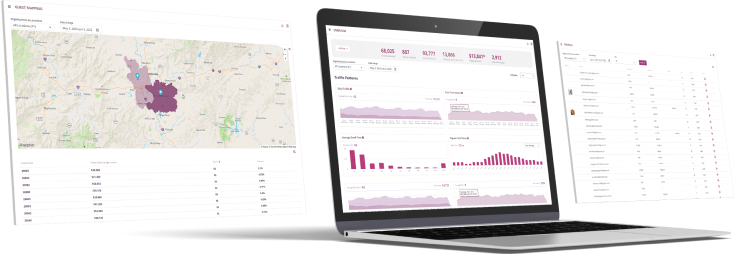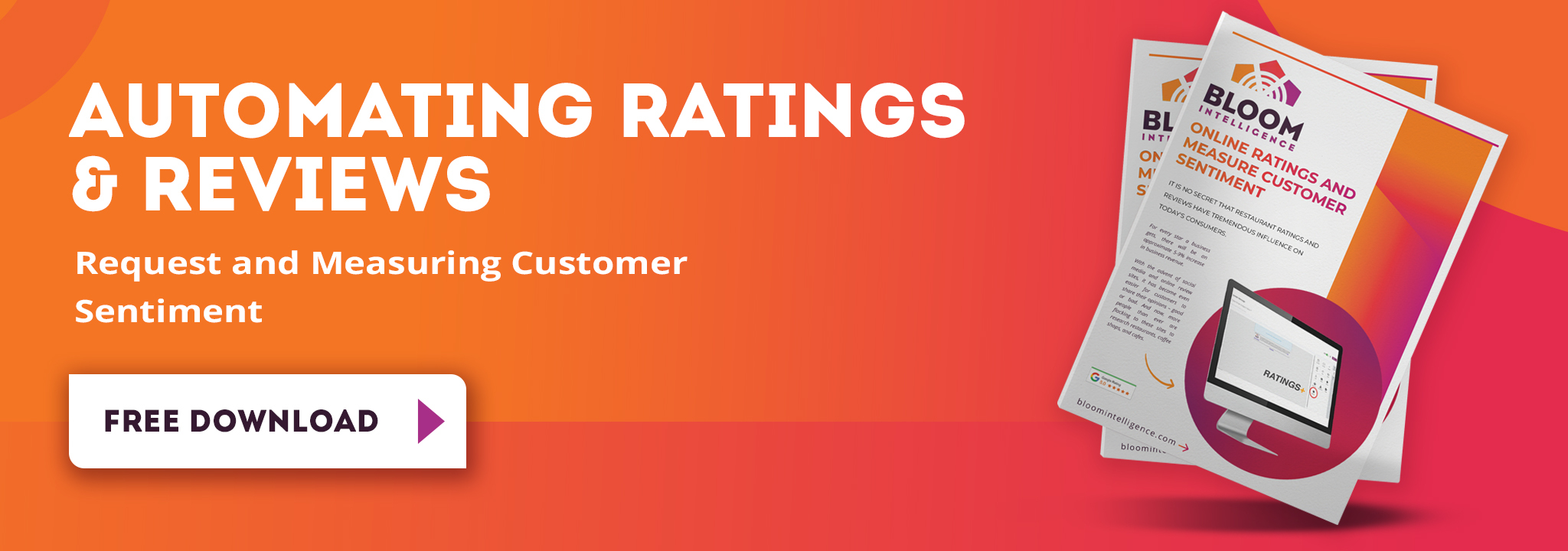If you’re a restaurant owner, you know that your guests are everything. A single bad review or a loss of your good reputation can hurt your business, so it’s important to make sure you’re doing everything you can to keep your guests happy.
Here, we’ll define exactly what first-party customer data is and give some tips on how to use it to improve your restaurant business.
In today’s uncertain economy with costs soaring and labor issues affecting guest satisfaction, having your own first-party data can be the catalyst you need to keep guests happy, coming back, and spending more.
What is First-Party Customer Data?
First-party customer data is data that restaurant owners collect directly from their guests.
The data is collected when guests log into WiFi, order online, fill out a form on your website, reserve a table online, or any other place – online or offline – where your guests engage directly with your brand.
First-party data is far more valuable for restaurant marketing than third-party data that can be purchased. It tells you what your real customers do and want, rather than giving you speculations about theoretical customers.

You will have clean, verified data about your very own guests.
What’s more, third-party data can be inaccurate and expensive, while first-party data is owned by you, extremely accurate, and very inexpensive.
Plus, by owning your own first-party customer data, you will be able to market to your guests when you need to most, and not have to pay for other platforms to drive revenue when you need it most.
How to Gather Your Very Own First-Party Data
To collect the most data, a restaurant customer data platform (CDP) is the most effective and inexpensive way to gather a very large amount of clean, verified guest data.
A CDP allows operators to easily centralize and automate the collection of guest data and behavior from multiple sources into a single database. It allows restaurant marketers to visualize and segment guest insights for much for effective marketing.
Advanced CDPs are unified with marketing automation and reputation management tools to automate the process of finding new guests, bringing back lost guests, and increasing your customers’ lifetime values.
In addition, it will track the effectiveness of your campaigns with detailed reporting. You’ll see how your messaging performs all the way back to a guest coming back to your location or ordering online, including transactions.

A unified platform also avoids data silos, where data is trapped in separate systems and can’t be used effectively across the whole business.
Here are a few of the latest statistics about the benefits of using a customer data platform. According to Aberdeen, September 2020, companies using a CDP saw:
- 9.1x greater annual increase in guest satisfaction rate.
- 2.9x greater year-over-year growth in annual revenue.
- 5.7x greater annual increase in guest spending.
- 4.9x greater annual growth in up-sell revenue.
In an unstable economy, the more you know about your guests and how your campaigns are performing, the better chance you will have to improve marketing return on investment.
According to the latest numbers from Black Box Intelligence, last month was the seventh month in a row (since March 2022) that same-store traffic growth numbers have been negative.
That is why it is so important to build a large guest database to remarket to using marketing automation. In addition, you can create lookalike campaigns to greatly increase conversion rates if you are planning on using, or using digital advertising.
Marketing Automation using First-Party Data
As mentioned earlier, an advanced CPD like Bloom Intelligence is unified with marketing automation and reputation management tools.
Marketing automation is the process of using your first-party guest data to send marketing messages to guests automatically. Messages are sent to individual guests as they meet specific criteria configured by the marketer.
Messaging can be personalized to individual guests or groups of similar guests to improve engagement and ROI. This is also referred to as customer segmentation.
For instance, if your guest data includes your guest’s birth date, you can configure the marketing automation platform to send a happy birthday message a few days prior to that date. It can contain an incentive to get the guest to choose your restaurant for their special day.
To personalize even more, you could create a different message for men and women, for example.
Or imagine you raise your prices to offset inflation, and this scares away once-loyal guests. Bloom’s marketing automation can identify these guests and target them with an offer to bring them back. (see how it works here)
Types of Campaigns
Plus, it is all done automatically. All you need to do is configure the campaign and monitor the results.
When a guest meets your configured criteria, a message is “triggered” and sent to the guest. Triggered messages can be sent based on:
- Milestone – when guests reach predetermined milestones such as their 10th, 25th, or 100th visit.
- Loyalty – every time a guest reaches a predetermined number of visits.
- Rating – when a guest provides a rating at or below a level you specify.
- Anniversary – when guests reach the anniversary of their first visit.
- Birthday – a configured number of days before a guest’s birthday.
- Upon Exit – a predetermined number of days or hours after a person leaves a location.
- Upon Registration – shortly after a guest first registers (logs in) on your WiFi, makes an online order or fills out a website form.
- At-Risk of Churning – when a guest has been determined as unlikely to return by our statistical model.
- At-Risk (number of days) – when a guest has not returned after a set number of days.
- Upon Order – a predetermined number of days or hours after a person makes an online order.
By using these powerful marketing automation campaigns, you’ll save time and money to concentrate on other areas of running a successful restaurant.
With a restaurant customer data platform, which gathers behavior data from multiple channels, attribution can be given very easily because it gives you the ability to measure results based on actual guest behaviors.
You’ll be able to see if a guest visited your restaurant, made an online order, left an online review on sites like Google or Facebook, completed a survey, increased their dwell time or PPA, or any other number of behaviors.
This gives you an accurate picture of how well your campaigns are performing.
Attribution can not only tell you how your campaigns are performing, but it can also help make them even better by allowing you to optimize and test your messaging over time with accurate, data-driven decisions.

Reputation Management Using First-Party Data
More and more, consumers are turning to the internet to help them make their dining decisions.
Rating websites like Google, Facebook, Yelp, and TripAdvisor receive millions upon millions of visitors every single day, and these sites can be one of your restaurant’s most powerful and relatively inexpensive marketing commodities.
The more positive ratings you receive, the more consumers will trust that they will have a pleasurable experience at your establishment.
Collecting first-party data can help you get more positive reviews while mitigating some of the negative reviews that can end up online.
But the truth comes in the research that has been done around these rating sites and the potential effects that restaurant ratings have on your overall bottom line.
A study performed by Michael Anderson and Jeremy Magruder, professors at the University of California, Berkeley, concluded that positive reviews have a direct correlation to increases in foot traffic during peak times. They found that a ½-star rating increase resulted in a 30-40 percent increase in the number of 7 pm bookings.
Another study conducted by Professor Michael Luca at the Harvard Business School sought a correlation between online ratings and actual revenue. The study found that a rating improvement of one star led to an increase in revenue of between 5 and 9 percent.
In 2017, websitebuilder.org collected data and statistics about the effects of good and bad user reviews. Among the data, here are some interesting facts they found:
- 72% of consumers say that positive reviews make them trust a local business more.
- 61% of consumers have read online restaurant reviews, more than any other type of business.
- 53% of 18-to-34-year-olds report that online reviews factor into their dining decisions, as do 47% of frequent full-service customers.
- 34% of diners choose a restaurant based on information provided on a peer-review website.
- Consumers are likely to spend 31% more on a business with excellent reviews.
Think about current foot traffic and revenue numbers at your establishment and you’ll further realize how important and valuable positive user ratings can be.
How First-Party Data Helps Improve Ratings and Reviews
Requesting ratings from your guests can be a very powerful way to increase and improve your online ratings and reviews.
Marketing automation with first-party data allows restaurant marketers to send out personalized messaging to guests after they have dined at their establishment or ordered online.
One type of message you can send is a request for a rating and review. The message includes a widget containing links to your accounts on sites like Google and Facebook. It will include the links to whichever sites you configure in your marketing automation platform.
It also contains a link where the guest can contact you directly if they had a negative experience.
When guests click on any of the links, they are taken directly to your review page on these websites. Then, when they publish their rating and/or review, it is also sent to Bloom’s CDP in real-time. This is all done automatically for you, behind the scenes.
You’ll see an immediate increase in the number of ratings and, over time, an inherent improvement.
Better yet, you will be able to monitor and respond to all of these ratings and reviews right from within the platform. As a result, Bloom users are reporting that many hours are being saved every week, depending on the number of locations, by executing this powerful automated marketing campaign.
The CDP also provides detailed reporting, plus you can literally see guest sentiment in the customer sentiment word cloud. This allows you to easily spot trends and make data-driven changes to your marketing and operations procedures.
Remarketing and Lookalike Campaigns
Remarketing is another powerful way to connect with visitors to your website, WiFi, online ordering & reservations platforms, or social accounts. It allows you to send targeted advertising and behavior-driven promotions to those people through online advertising or email marketing.
Remarketing is a key marketing concept that should be a primary focus of restaurant owners and marketers.
By collecting guest contact information, ideally their verified email address, marketers can send unobtrusive branded promotions, bounce-back offers, surveys, newsletters, and other valuable information to their targeted lists of email subscribers.
This further strengthens brand awareness, by placing your brand in front of your customers repeatedly.
You can also use your customer list to target online advertising on Facebook or Google and its partner sites.
These powerhouse websites are eliminating their cookie- and pixel-based targeting. So now, the only way to advertise on these platforms to your guests (remarketing) is to upload your own first-party data.
Then, your targeted ads will be shown only to those who have been added into your CDP.
You can also take this a step further and execute lookalike campaigns. This is a very powerful way to find and lure new guests to your locations.
After uploading your own first-party guest data, Google and Facebook will analyze the online behavior and demographics of your guest list. Then they will send your targeted messaging to those who match the characteristics and behavior patterns of the guests in your list (lookalikes).
According to Google, these lookalike audiences can boost the performance of your ads to the tune of 60% more impressions, 48% more clicks, and 41% more conversions.

The Data Doesn’t Lie
In order to understand the value of first-party data and how it can be used, it’s important to understand what it is. First-party customer data is information that restaurants collect from their own interactions with guests or website visitors.
This type of data will include any interaction between a restaurant and its guests that you can track and measure.
By understanding how to gather this data, and using the tips provided above, you can use it to improve your marketing automation efforts, create remarketing or lookalike campaigns that are highly targeted and effective, manage your reputation better online and improve your ratings and reviews.
Bloom Intelligence Customer Data Platform
If you are ready to start building your own powerful restaurant customer data platform, saving time and money, and collecting your own first-party guest data from all of your channels, take a look at Bloom Intelligence.
By building your own restaurant customer data platform you will take control of your own first-party guest data, and unlock guest insights that will improve the success of your business. Likewise, you may be able to eliminate some of your other marketing costs.
Then, combine this with our unified WiFi marketing automation and reputation management to save time with automation, and money with the consolidation of services into one unified platform.
In today’s competitive environment, Bloom can give you the competitive edge for success!
If you’d like to see the Bloom restaurant marketing platform in action, and discover how you can grow your business through guest intelligence and marketing automation, schedule a free demo or call 727-877-8181.








.svg)